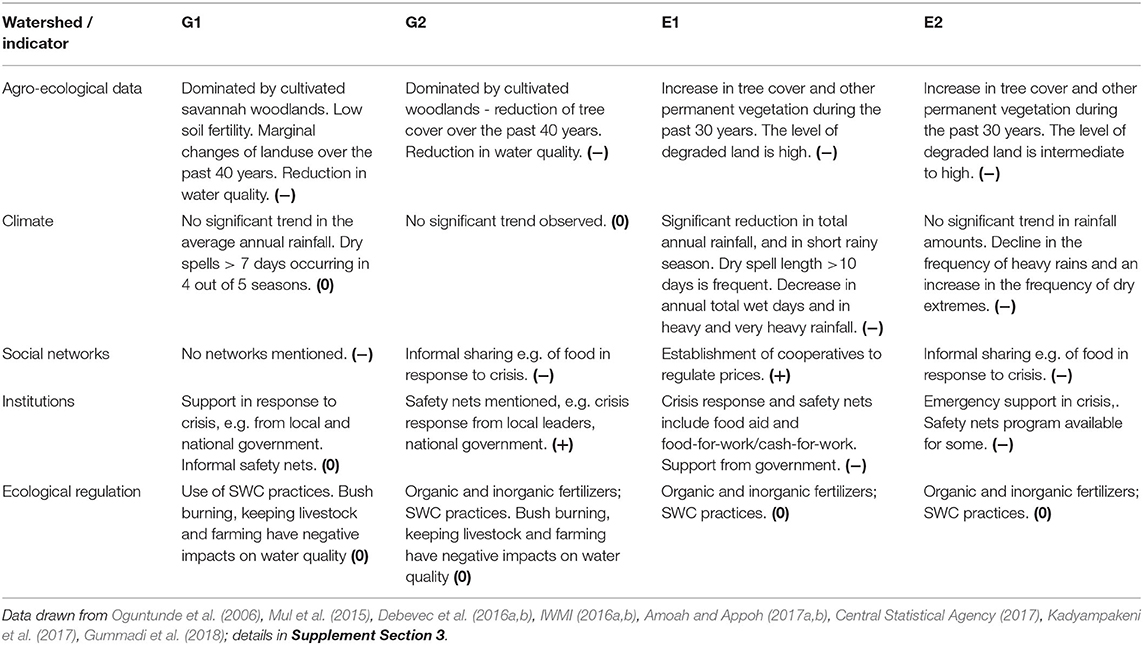- 1Department of Soil and Environment, Swedish University of Agricultural Sciences (SLU), Uppsala, Sweden
- 2Consultative Group for International Agricultural Research, Research Program ‘Water, Land and Ecosystems', Colombo, Sri Lanka
- 3Independent Consultant, Malmö, Sweden
- 4Independent Consultant, Colombo, Sri Lanka
- 5International Water Management Institute (IWMI), US Office, Washington, DC, United States
- 6International Water Management Institute (IWMI), West Africa Office, Accra, Ghana
Rainfed smallholder farming is particularly vulnerable to climate change, which can greatly exacerbate existing poverty and livelihood challenges. Understanding the complexity of the systems that connect the environment, society and people can help us to reduce this vulnerability and increase the resilience of communities and households to climate perturbations. In recent years, resilience theory has proven a useful approach for exploring the complexity of development challenges. As a result, there has been an increase in the development of tools and frameworks for assessing resilience. Despite this increased focus, there is no consistent use of the resilience concept in development practice and little evidence as to the benefits of using the tools. This paper aims to bridge theory and practice by coupling research on resilience with its application in the international development field. The specific hypothesis we explore is if and how rural livelihoods build resilience toward increased climatic variability in already degraded agro-ecological landscapes? We present a resilience framework with indicators to assess the extent of community resilience to climate change through improved local agricultural production and natural resources management. Primary and secondary landscape and community data, together with development of participatory watershed action plans were used to populate 16 indicators in a resilience framework baseline for the two rainfed dominated watersheds in Ethiopia and Ghana respectively. Given community awareness of the challenges related to the watershed natural resources, local agriculture and extreme weather, the communities were very willing to develop action plans to improve their management of natural resources and build climate resilience. Nevertheless, our analysis of the watershed action plans revealed that strengthening resilience through local action alone, would likely not be sufficient to meet all climate -livelihood challenges identified. To address severity and recurrence of climate change related disturbances, such as droughts, floods and disease in poverty-affected rural communities, the capacity to improve resilience will depend on external factors, in addition to inherent action. New knowledge, infrastructure and social security mechanisms, including insurance and emergency assistance need to added to build resilience for poverty-affected communities in degraded watersheds. We conclude there are also challenges in the use of resilience framework for development and climate-action related to rural poverty affected and degraded livelihood systems. Populating complex social–environmental systems will also need further development, to understand progress in resilience building under changing climate. Special attention to systemic indicators that describe the coupling and interdependencies of social-ecosystem factors will be critical to take action.
Introduction
Climate change, rainfall variability and water insecurity with recurrent incidence of droughts and dryspells affecting food security is estimated to affect 3.2 billion people, of which 1.4 billion is living in rural settings (FAO, 2020). Latest report by IPCC (2021) re affirms that incidence and duration of precipitation and other weather related extreme events is already affecting multiple regions, with both more heavy precipitation and more incidence of agricultural and ecological droughts. In sub-Saharan Africa, smallholder farming is a main source of income and livelihood and an intervention area for poverty alleviation and development. Poverty persists, especially in rural areas, where livelihoods are closely related to agricultural production (Katsushi et al., 2018). These areas are already affected by land degradation and soil nutrient depletion (Leakey et al., 2009; Barrett and Bevis, 2015), making it a challenge to increase yields at a pace commensurate with population growth. Land degradation affects the well-being of over 3.2 billion people in the world, with the greatest impacts felt by the most vulnerable groups (IPBES, 2018). Furthermore, a high probability of drought and dry spells (Hyman et al., 2008; Rockström and Falkenmark, 2015; Gautier et al., 2016) make farming systems on degraded land particularly vulnerable to pressure from variable climates. Together these slow and fast social and environmental changes have severe impacts on rural smallholder farming systems, contributing to persistent poverty (e.g. Barrett and Bevis, 2015; Enfors, 2015; Grace et al., 2017). One action to support development is to use participatory pathways for better managing agricultural production systems and local natural resources. The approach are considered key to anticipating and adapting to challenges of weather and climate degraded land and productivity and livelihood impacts, to increase the resilience of rural agricultural communities.
Resilience is a useful concept for capturing the complexity and interactions of social-ecological systems (Folke et al., 2010; Cote and Nightingale, 2012). While definitions vary, for the purposes of this study, resilience is defined as “the ability of a system and its component parts to anticipate, absorb, accommodate, or escape from unacceptable standards of living due to the effects of a hazardous event, in a timely and efficient manner (Douxchamps et al., 2017).” In other words, resilience describes the capacity of communities in a given context or landscape to maintain and improve their livelihoods—despite stressors and shocks—through the sustainable management of natural resources while maintaining key ecological functions.
The concept of resilience is increasingly being embedded in development policy at global, regional and national levels (Brown, 2015). For example, resilience to climate change is a fundamental element of several United Nations Sustainable Development Goals, including the goals on poverty reduction, food security, infrastructure, urbanization, climate change and oceans (UNGA, 2015). The Paris Agreement emphasizes climate resilience and the resilience of socio-economic and ecological systems (UNFCCC, 2015) and the Sendai Framework for Disaster Risk Reduction 2015–2030 calls for increased resilience to disasters (UNISDR, 2015). At regional and national levels, resilience is a key focus of policies that address climate change impacts, for example, through commitments to creating climate-resilient communities and economies in the framework of Agenda 2063, The Africa We Want (African Union, 2015), or to increasing agricultural production, in the framework of the African Union's Malabo Declaration on accelerated agricultural growth and transformation for shared prosperity and improved livelihoods (African Union, 2014).
In academic literature, writing on resilience dates back at least to the 1970's (e.g., Holling, 1973; Berkes and Folke, 1998; Carpenter et al., 2001). Efforts to link resilience theory to development have increased in recent years as a means to strengthen capacities to cope with climate-related challenges and to contribute to poverty reduction. Berbés-Blázquez et al. (2017) identify multiple overlaps between development resilience strategies, specifically noting the need to adopt a complex systems perspective. To address the different interpretations of resilience across disciplines, Xu and Kajikawa (2017) developed an integrated framework aimed at a generalizing the concept, outlining the principal components irrespective of disciplinary approach. The authors considered aspects of system flexibility, redundancy, diversity, and connectedness. They paid special attention to external and internal slow and fast systems components, to enhance resilience for desired systems outcomes.
The use of resilience to address climate challenges has prompted advances in the development of practical tools for applying resilience theory. Although there are many approaches to measuring resilience in development practice (UNDP, 2013; Béné et al., 2014; FAO, 2015; Quinlan et al., 2015; Douxchamps et al., 2017; Sellberg et al., 2017), there is little evidence of what can be achieved when different tools are applied. Key challenges concern what to measure and how, to gauge progress and change. Based on a review of more than fifty resilience tools and methodologies, Douxchamps et al. (2017) found that further studies are needed to ensure that resilience theory is fully grounded in empirical observation, and that more attention is paid to the systemic dimensions of social-ecological systems (SES) for accelerated development subject to changes, such as development and climate change.
This paper aims to bridge theory and practice by coupling research on resilience with its application in the international development field. The specific hypothesis we explore is: can rural livelihoods build resilience toward increased climatic variability in already degraded agro-ecological landscapes? To explore this, we present results from the implementation of community-developed watershed action plans aimed at supporting community efforts to improve watershed management for building resilience to climate-related stressors and shocks. We develop baseline data for measuring progress of community resilience related to the agro-ecological landscape and to the dominant livelihoods. And finally we analyse the proposed community plans of action, with specific interest to the systemic indicators, that are key to capture the interconnectedness between the components of the social-ecological system. The protocol was piloted in four watersheds dominated by smallholder farming systems in rainfed agriculture: two in Ghana and two in Ethiopia during 2016 and 2017.
Methodology
Protocol for Assessing Resilience in Rural Communities
The protocol applied in this paper follows the resilience assessment components of developed by Douxchamps et al. (2017) based on the Common Analytical Model for Resilience Measurement (Constas et al., 2014). It involves a mix of methods for data collection and analysis, which take into account multiple perspectives and governance levels. The specific approach in data collection is outlined in Table 1 and in Supplementary Section. In summary, three main approaches were used. Firstly, desk reviews from open access publications and public records were used to the finest spatial resolution and most updated record. For assessing historic watershed landuse change and rainfall data, remote sensing products (Supplementary Section 2). Finally, the community-developed watershed action plans, following the IWMI (2018) “Sustainable Management of Water, Land and Ecosystems for Resilient Communities: Community Workshop Modules” tool were used for qualitative information and analysis of the proposed progress toward climate resilience, in respective location (Figure 1).
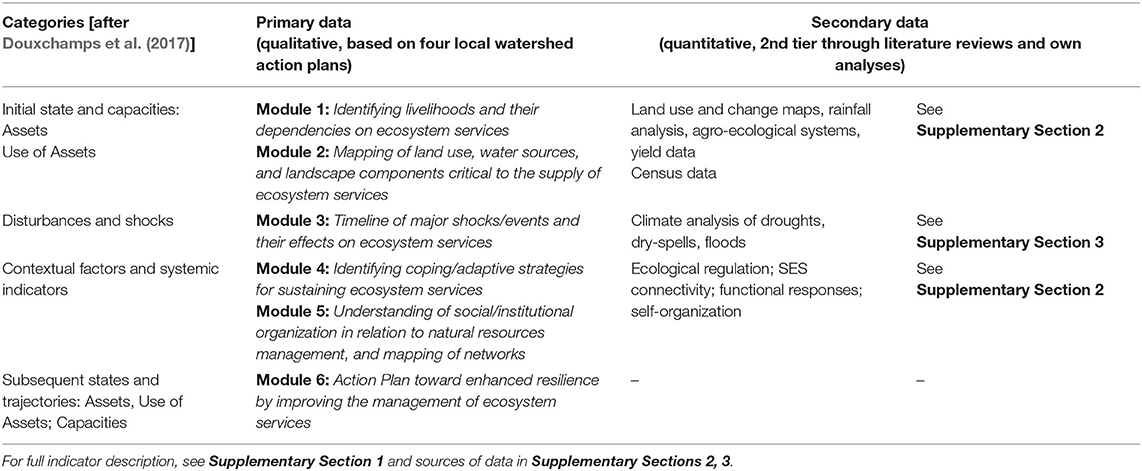
Table 1. List of indicator categories indicators [adopted from Douxchamps et al. (2017)] and sources of data for measuring the resilience of the agro-ecological systems in G1, G2, E1, and E2 watersheds [adopted from Douxchamps et al. (2017)].
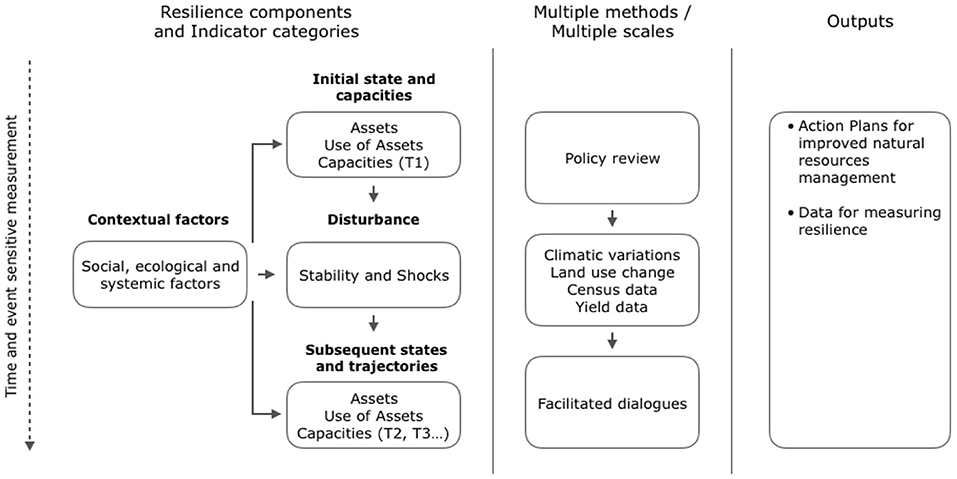
Figure 1. Schematic figure outlining data collection related resilience framework components [after Douxchamps et al. (2017)] in the research study, using a mixed method approach to assess resilience which included landscape assessment using remotes sensing, climate data, desk study of census data and policy review, and the analysis of the community-developed watershed action plans.
The data was then measured against an identified set of indicators (see Table 1) derived from Douxchamps et al. (2017) to reveal the baseline level of resilience. The indicators were grouped into three categories: (i) initial states and capacities, which includes indicators on poverty, education, agricultural management, water and sanitation, and livelihoods and strategies to anticipate, absorb, accommodate, or escape stressors and shocks; (ii) context, including indicators on agro-ecology and climate, institutions and social networks, ecological regulation, functional responses, and connectivity. The systemic factors are particularly important for this indicator category as they have been identified as a gap in many resilience measurement frameworks (Douxchamps et al., 2017). Systemic factors (environmental regulation, self-organization, functional responses, and connectivity) capture the links between systems components, both within the ecological and social systems respectively, as well as between the ecological and social aspects of the watershed. For example, access to inputs, such as irrigation, fertilizers, and pesticides, can result in higher yields, and have a positive impact on household incomes and increase resilience. However, such management practices can also result in the degradation of water surface and groundwater resources, if applied inappropriately, and hence can be considered an indicator for social-ecological system (SES) connectivity indicator. The final indicator category is iii) disturbance, which includes indicators on type, frequency, intensity and effects of shocks and stressors. For the purposes of this study, shocks and stressors were measured at community and district levels based on primary and secondary sources, to provide both objective and subjective understanding of the timing, length and effects of events over the past 25 years. This category also includes the recognition of undesirable stable states.
The indicators are listed in Table 1 and in Supplementary Section 1 section for full description and in Supplementary Section 2 with references to primary and secondary data sources for indicators.
Case Studies in Ethiopia and Ghana
Ethiopia, despite sustained economic growth, remains one of the world's least developed places, ranking 173 out of 186 countries in the 2020 Human Development Index (UNDP, 2020). Weather related extremes are frequent, both as droughts and floods, that affect the largely agriculturally dominated livelihoods and economy. In Ghana, despite increasing growth at the national level and in the south of the country, there are still regions where poverty remains high and infrastructure is poorly developed (Ghana Statistical Service, 2015). In these regions, addressing climate change and other development challenges is vital to reducing poverty and to responding to the vulnerability of rainfed farming systems to climate and temperature variations. The national policy environments in Ghana and Ethiopia provide space for actions to increase resilience to climate change. In Ghana, a review of policies on climate change, environmental resources management and agricultural production found that resilience has featured in policy and strategy documents since 2012 (IWMI, 2018a,b). For example, the MESTI (2013) includes resilience among its objectives for agriculture, infrastructure, water land systems and vulnerable communities (MESTI, 2013) and the Ghana Shared Growth and Development Agenda (GSGDA) II (2014–2017) promotes crop varieties that are resilient to climate change (Giordano and Cofie, 2017). In Ethiopia, strengthening resilience is an explicit policy commitment at the national level (Barron and Debevec, 2016). The Federal Democratic Republic of Ethiopia (2011); FDRE (2012) identifies the sectors that are most vulnerable to climate change and calls for the development of adaptation plans targeting agriculture, health, water and energy, and the building and transport sectors (Federal Democratic Republic of Ethiopia, 2011). There is also a Desta et al. (2005) aimed at strengthening resilience to climate-related shocks through proposed measures to increase incomes (Federal Democratic Republic of Ethiopia, 2005).
The community developed watershed action plan process was applied in four agricultural watersheds in the Southern Nations, Nationalities and Peoples' Region (SNNP) and Tigray regions in Ethiopia; and in the Upper East and the Northern regions in Ghana. The locations were selected based on the current livelihood systems being dominated by rainfed agriculture, with marginal options for alternative income sources whilst being subject to current or future water resource limitations in landscapes. The four watersheds (Table 2) will be referred to as E1, E2, G1, and G2. In Ethiopia, one of the selected sites had links to ongoing rural development projects (E1), while the second one—selected for comparative purposes—did not (E2).
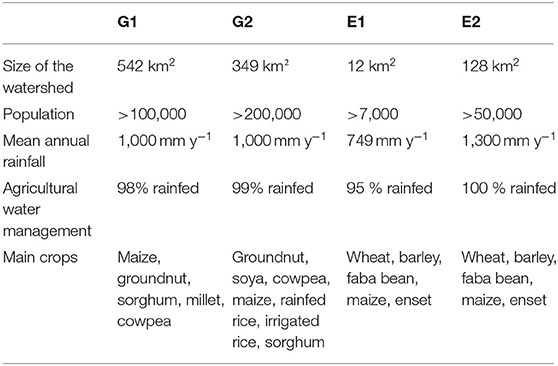
Table 2. Characteristics of the selected watersheds (Oguntunde et al., 2006; Ghana Statistical Service, 2015; Mul et al., 2015; Adimassu, 2016; Kadyampakeni et al., 2017).
Between 70–80% of the population in G1 and G2 live in rural areas (Ghana Statistical Service, 2015). In Ethiopia, 90% of all rural households rely primarily on agricultural activities. In the watersheds, communities depended almost completely on rainfed farming. Longterm average annual rainfall ranges from 749 mm y−1 in E1 to 1,300 mm y−1 in E2 (Adimassu, 2016), and 1,000 mm y−1 for G1 and G2, respectively (Kadyampakeni et al., 2017).
The community developed watershed action plan (section Protocol for Assessing Resilience in Rural Communities) was piloted in the two watersheds E1 and E2 in Ethiopia in May-June 2016. It was further refined and contextualized with a second trial in the two watersheds in G1 and G2, Ghana in June-July 2017. Facilitated dialogues in local language were organized in the four watersheds to develop the local action plans to build resilience. Results were shared back to communities, 6 months after respective workshop. All participants at all events were informed and consented to the information generated during workshops to be used for research purposes, following IRB standards. The facilitated dialogues to develop local for resilience building action plans followed the protocol described by IWMI (2018). The workshop was divided into modules corresponding to the Table 1 indicators, where participants were guided through the modules and jointly developed consensus on current state and proposed action plans to build climate resilience in respective watershed. These action plans were analyzed by the research team, and used as primary data to inform on the state and capacity of social-ecological resilience of the four communities in the watersheds. The dialogues included communities from down-, mid, and upstream locations in each watershed, and 20–40 participants per workshop included elderly, young, male and female community members, local government agencies, and representatives from NGOs and watershed experts working with the respective communities. Secondary data was derived from official sources on census, climate and rainfall, land use change, and through policy analyses to triangulate and /or quantitate qualitative statements developed during the workshops by participants.
Scoring System for Resilience Indicators
We applied a 3- grade scoring system to all indicators of the resilience framework, populated with data according to Table 1 and Supplementary Sections 2, 3. The 3-grade indicator scale provide a course indicator to guide the baseline of resilience of the agro-ecological systems in E1, E2, G1, and G2 watersheds [indicators adopted from Douxchamps et al. (2017)]. The level of resilience was interpreted through the indicators in order to compare different contexts and understand whether and how resilience changes (Hills et al., 2015). The groups of indicators were scored as to the effect on the community's resilience to climate change, where (+) indicates that the state of the measured indicator is positive; (0) indicates no effect, and (−) indicates a negative effect. The indicators for resilience framework categories “contextual factors and systemic indicators” and “Disturbances” are detailed in Table 3. For full list of indicators, see Supplementary Section 1.
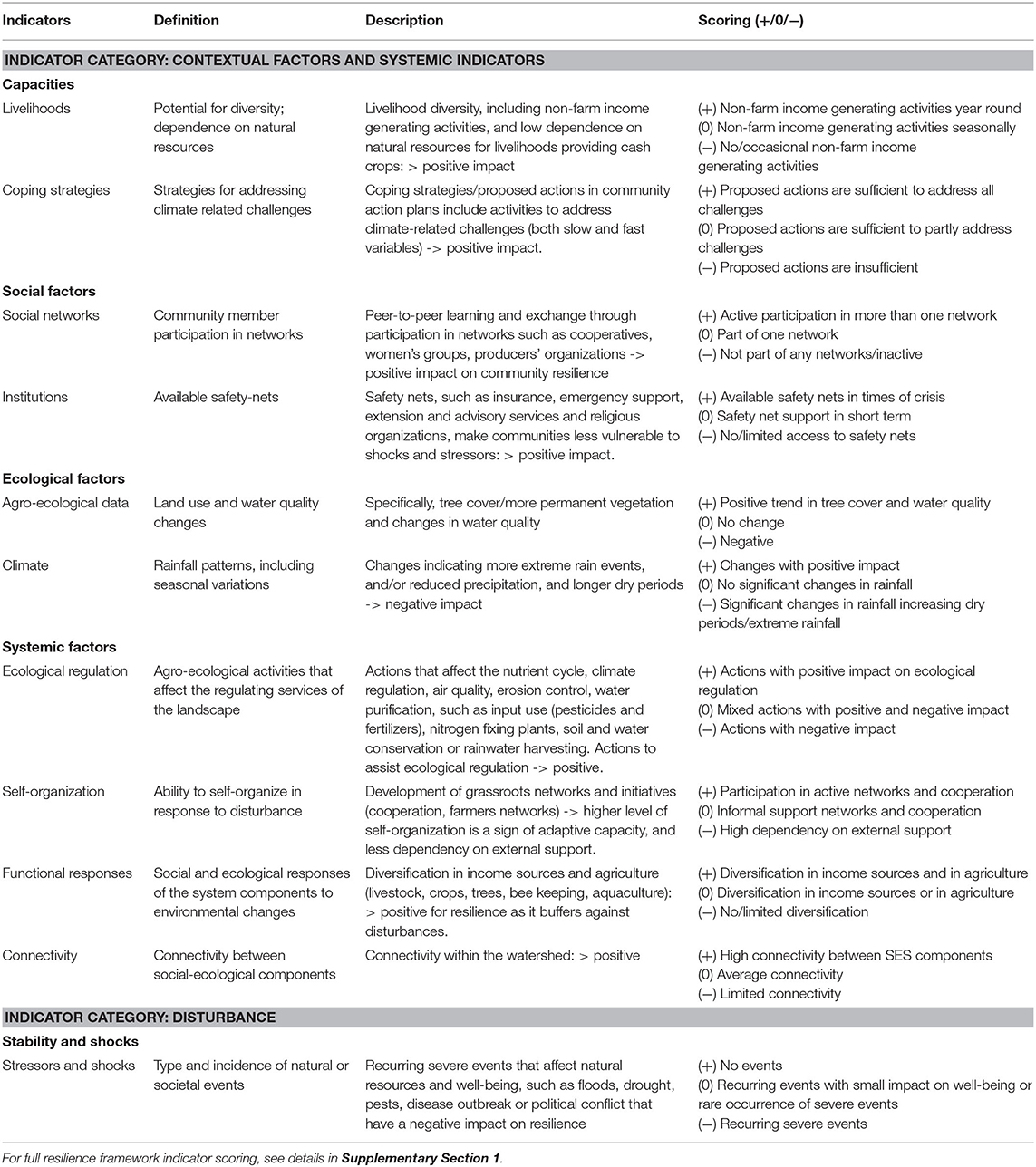
Table 3. Extract indicator category “Contextual and systemic indicators” and “Disturbances” and relative scoring.
Each indicator category was then weighted to provide a relative value per category per overall watershed, in terms of resilience for climate disturbances, taking into account the livelihood and community network.
Results
Initial States and Capacities
Initial State and Assets of Livelihood Systems
When assessing indicators describing initial state of the four watershed and communities, we found Ethiopian sites E1 and E2 being in a relatively less developed state, with higher incidence of poverty, smaller farm sizes, lesser degree of literacy and less developed drinking water and sanitation facilities (Table 4). The major difference was the level of access to improved sanitation, with 10–15% of households lacked improved sanitation in G2 and G1, and 94% lacked improved sanitation in E1 and E2. Access to improved water sources also differ widely, with nearly 80% access in G2 and just above 40% in E2. Notably, all four watershed community consultation reported practices of soil and water conservation (SWC) management to enhance rainfall infiltration and reduce rainfall runoff and sediment losses from crop fields. However, the lack of developed water storage could have negative implications for broader water insecurity and climate resilience in the rainfed-dominated agriculture systems of E1 and E2.
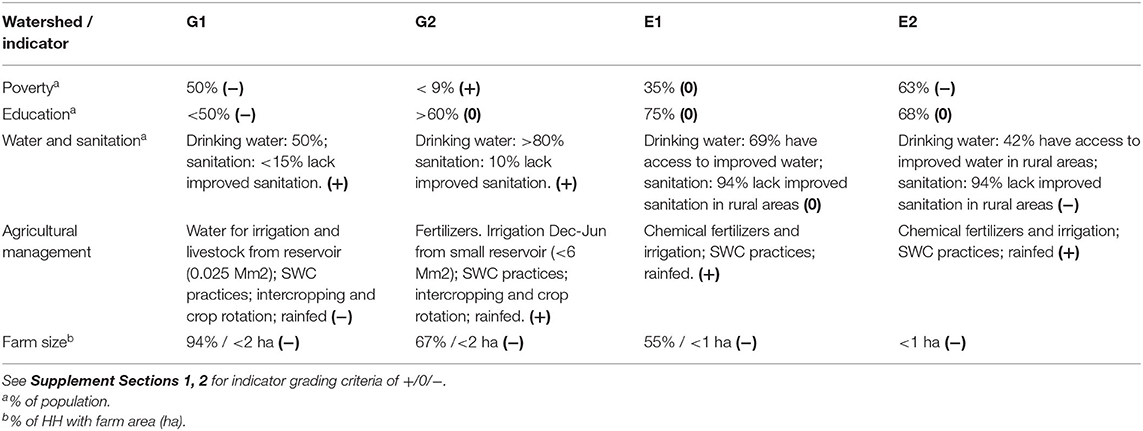
Table 4. Indicator scoring on assets and use of assets for the four watersheds G1, G2, E1 and E2 [data derived from primary and secondary sources from: WFP (2012, 2014), Ghana Statistical Service (2013), Debevec et al. (2016a,b), IWMI (2016b), Amoah and Appoh (2017a,b), Central Statistical Agency (2017)].
Capacity to Cope With Stressors and Shocks
The capacity to deal with risk and/or stress is an important indicator of resilience building. When consulted in the development of action plans, there were an inherent challenge of seasonal migratory labor out of communities, especially younger male, but also female. Internal remittances therefore played a role in all four watersheds. The communities in all four watersheds relied on a mix of agricultural activities for their livelihoods, ranging from beekeeping, livestock, shea butter production, aquaculture, and crop production. This diversity was often adding important albeit small incomes.
The results of analyzing the community developed watershed action plans showed that there was a willingness to improve natural resources management. Communities identified and proposed a range of actions to cope with various climate and natural resources-related challenges, in order to improve livelihoods and natural resources in the watershed (Table 5). Proposed action included both behavioral change for community or individuals, such as dietary change, awareness raising and regulatory efforts, and pro-active measures to adapt, and re-inforce natural habitats and ecosystems functions (i.e., tree planting, more SWC practices). Most of the proposed actions were actions already undertaken or well-known in the community, as actions undertaken in the past, to address watershed degradation (i.e., SWC, tree planting) or when disturbances occurred (i.e., migrate, change diet when crops fail, sell livestock). Most communities explicitly recognized the importance of capacity building and awareness raising as an important component to build an action plan for resilience in the watershed. Only one location (G2) explicitly mentioned alternative coping strategies to diversify income generation through e.g., sale of livestock, or through migration for seeking alternative labor opportunities.
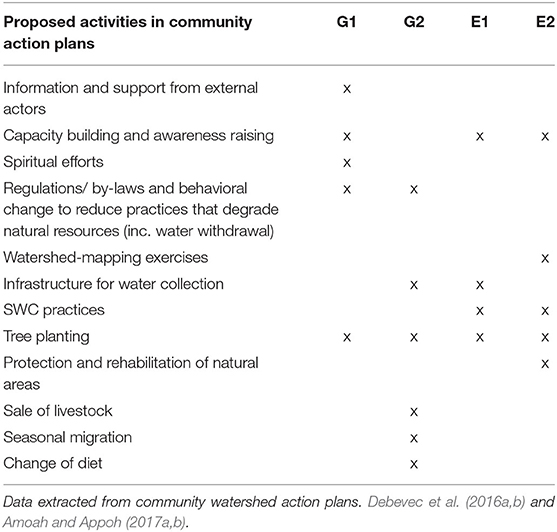
Table 5. Summary of proposed natural resource management actions to build resilience in respective watershed (E1,E2, G1,G2).
Contextual Factors and Systemic Factors
Contextual factors included indicators on climate and ecosystems, social and systemic factors and the change of these factors (Tables 6, 7). In this protocol, focus was in particular on rainfall patterns and landuse changes of the four cases studies. Overall, only weak signals of rainfall change could be identified, with potential serious implication for the rainfed agricultural production systems. In G1 and G2, the incidence of dry spells of more than 7 days was likely to occur in more than 80% of seasons, with potential implication of yield reductions (Kadyampakeni et al., 2017). In E1 and E2, rainfall analyses over the last 20 years showed a re-distribution of rainfall with decrease in annual wet days, as well as a decrease in heavy rainfall (Gummadi et al., 2018). In E1 there short rains (Belg) had significantly reduced and were no longer considered for crop production (Supplementary Section 3) Unexpectedly, the landuse change analyses showed that the permanent vegetation (tree cover) had increased in E1 and E2, and remained largely unchanged between 1987 and 2017 in G1 and G2, but spatially redistributed (Supplementary Section 3).

Table 7. Indicator scoring results on contextual systemic factors for the four watersheds G1, G2, E1 and E2.
Regarding social factors “institutions” and “social networks,” consultations with local communities in development of action plans showed that there are formal and informal social networks in place in the event of a crisis for most of the communities in the four watersheds. In response to drought, support included receiving seedlings and awareness efforts around bush burning from the Ministry of Forestry and Agriculture (G1); technical expertise for improved farming practices from agriculture extension officers (G2); and food aid from the government (all watersheds).
A range of institutions were identified for various roles in managing natural resources in the different watersheds. The communities in G2, E1, and E2 identified themselves as having a key role, but this was limited to labor rather than decision-making. All of the communities relied mainly on their district assemblies to address issues around natural resources management. Public service agricultural extension officers were identified as having great influence on farming activity through information sharing and training. Local and international NGOs also provided such services as well as funding.
The systemic factors (environmental regulation, self-organization, functional responses, and connectivity) capture the links between systems components, both within the ecological and social systems respectively, as well as between the ecological and social aspects of a community and the watershed (Table 7). Land degradation was perceived as high across all four watersheds, and in G1 and G2, changes in water quality were linked to activities such as farming and keeping livestock. Communities only connected downstream water resource issues (water quality, water quantity) with community use upstream in the action plan development. We interpreted this as there was marginal awareness of the respective communities and the use of natural resources actual and potential effects in the watersheds (G1, G2, and E2). This unawareness of connectivity between use and emerging effects suggested a limited capacity to address challenges related to the dynamics, such as upstream-downstream water pollution. Other natural resources that may be implicated were the use of communal land (E1, E2), and abstraction of surface water upstream.
Disturbance
Stability and Shocks
The data on stability and shocks focus on events with both slow and fast incidence of change, including drought, floods, storms, erosion and landslides, fires, pest and disease outbreaks, market (price structure) collapse and political conflicts, as mentioned by the communities in the action plan development process. Figure 2 shows the type and frequency of events over a 25-year period that the participants recalled as a community in respective watershed. The events present the perspective of the communities, although not always possible to triangulate with independent verification, such as rainfall analyses. The data suggest that stressors and shocks were multiple and frequently recurring, which exacerbated the impacts of natural climatic variability on communities and watersheds. Most locations experienced either too little or too much rainfall every 3–5 years. E2 was particularly exposed to frequent floods, droughts and erosion events, -a significant challenge since these types of events require different responses. G2, on the other hand, only experienced a few events and listed none after year 2000. Interestingly, all of the watersheds listed fewer shocks during the period 2005–2015 than before 2000. It is unclear if this an indication of improved coping strategies, or a reflection of methodological weakness (i.e., workshop participant age distribution, and/or with impaired memories).
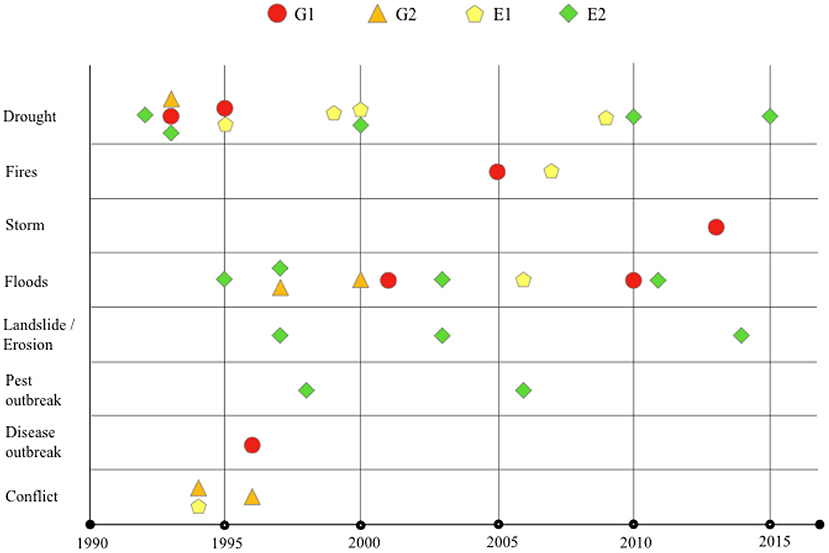
Figure 2. Frequency and type of shocks and disturbances during the past 25 years (1990–2015) as recalled by the communities in the four watersheds during the consultative development of watershed action plans. Data drawn from Oguntunde et al. (2006), Debevec et al. (2016a,b), IWMI (2016b), and Amoah and Appoh (2017a,b).
Summary of Resilience Indicator Status
To compare the four case watershed baseline of resilience, the 16 indicators were average into the resilience framework indicator categories “Initial state and capacities,” “Contextual and systemic factors,” and “Disturbances” (Figure 1). Figure 3 summarizes the results from the three categories of indicators as presented in Tables 4–7 and Figure 2. The results indicate the relative level of resilience in the different watersheds, specifying weaker and stronger components in each watershed.
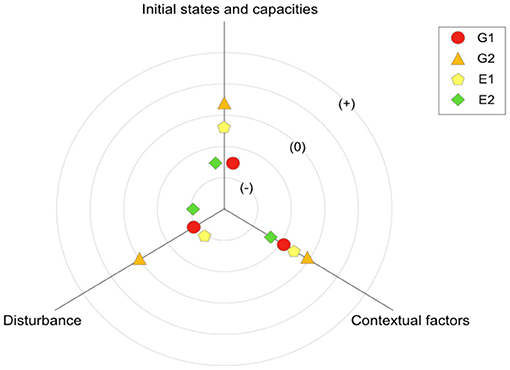
Figure 3. Summary result for baseline resilience based on resilience framework indicator categories for four cases E1, E2 G1, G2. (−) decreases the resilience of the system; (0) does not impact the resilience of the system, negatively or positively; (+) positively impacts the resilience of the system.
The G2 watershed stands out, since its average score was highest across the indicator categories. The ability of G2 to anticipate, absorb, accommodate the impacts of shocks and stressors exceeded that in the other watersheds, as indicated in the proposed actions in the community action plans. A key factor could be the community's proximity to a large city, which provides access to health, education, markets and information, which exceeds any other watershed.
In terms of disturbances, here related primarily to drought and flood events, E1, E2, and G1 are already having a historic and current high exposure to extreme weather events. Due to the contextual and systemic category also scoring negative, we interpret this as an inherent weak capacity to build resilience, and therefore also two concurring set of indicator categories further act to set back this capacity.
E2 consistently scored slightly lower than the other watersheds. Poverty levels were higher and access to water and sanitation services were lower. Despite greater rainfall levels, land degradation was a challenge and there was an increasing trend in dry extreme events. A key aspect was also low connectivity and access to key infrastructure, which is important for external support in the event of disturbances.
Discussion
Capacity to Increase Resilience in Ghana and Ethiopia Case Studies
We explored the capacity to build resilience in four rural communities of smallholder rainfed dominated agriculture, highly dependent on past and current weather and local natural resource base in watersheds. Data for a baseline in resilience was established, using a mixed method approach combining primary evidence through a consultation process and secondary complementary data on climate, landuse, and statistical livelihood context from multiple sources. We acknowledge it does not reflect individual perspectives on well-being, or differences in well-being among different groups and individuals. Nevertheless, the data enables a baseline understanding of the communities' potential to respond to climatic events or other external or internal stressors and disturbances, such as extreme weather events expected to be on the increase (e.g., IPCC, 2021). The capacity to respond to shocks and stressors varied between the communities. While all of the communities were eager to reduce the impact of climate change and current landscape degradation through watershed management with additional natural resources management efforts, the proposed action plans were unlikely to be sufficient to address slow variables or severe shocks, such as prolonged or more recurring drought events, severe floods, or soil fertility decline. In a recent study, Findlater et al. (2018) confirmed that even well-resourced farmers struggle to adopt climate change management approaches, despite incentive and willingness to adapt.
Drought is a particular challenge. Historically, the response to severe droughts included external food aid from government agencies and NGOs. The community response to such events included migration (E1, E2), selling livestock (G2), or change of diet (E2)—actions that can help temporarily (e.g., seasonal dry periods), but which can lead to decreased resilience in the long term. Labor migration tends to age the rural populations, and undermine willingness to invest in longterm interventions. Change in climate parameters have been shown to negatively affect child early year development (e.g., Randell et al., 2020) and the most likely pathways were proposed to be change in diets due to limited food supply by agriculture. Furthermore, recurring severe shocks can act as a disincentive to investment in agriculture (Hansen et al., 2019) and thus undermine necessary climate adaptation.
Other measures that can support resilience but were not mentioned by the communities, include strengthening market access, (micro) loan facilities, savings or insurance mechanisms. In a review of climate risk interventions, Hansen et al. (2019) found that institutional interventions, such as insurance and social-protection programs, alongside improved farming practices, can increase the ability of smallholders to cope in the event of a severe shock, including climate and extreme-weather related shocks. Notably, whereas all action plans included elements on information access, awareness making and capacity (knowledge) strengthening, these are generally not possible to address within communities themselves. Identifying solutions to new and complex challenges, such as livelihood- environmental development, sustainability and climate adaptation, tend to require innovation and knowledge often sourced externally, merged with local knowledge.
The systemic factors revealed that the communities had practices that could increase resilience by increasing yields, such as the use of organic and inorganic fertilizers, or keeping livestock, which increase livelihood benefits, but can simultaneously result in water quality changes. Other practices such as SWC practices often proposed to reduce climate change impacts are already in place. Hence, it is doubtful if “more of the same” will strengthen resilience further, especially as the main variable of rainfall is increasing in variability or even declining in seasonal amounts (Table 6). Chemura et al. (2020) suggest that current rainfed crops of maize, sorghum, cassava and groundnut in Ghana, is already cultivated under suboptimal agro-ecological conditions, and these will be increased by >12% under expected climate change. Appropriate and diversified agricultural management practices can support stable production and have a positive impact on resilience (Hansen et al., 2019). However, management practices can also result in the degradation of natural resources if, for example, they lead to water pollution into surface and groundwater sources, unsustainable water withdrawals or soil degradation. These aspects need to be managed at an integrated landscape—watershed scale to balance opportunity with potential negative impacts within other resource users or downstream area of practice.
Challenges in Application of the Protocol in Ghana and Ethiopia
This paper provides a snapshot of the current state of resilience in the four watersheds. Understanding the relative change in resilience over time will require tracking changes over time. The timing of the measurements, taking into account seasonality, will be important for enabling comparisons (Barrett and Constas, 2014). Data gathering and verification is a continuous problem, which calls for mixed methods approaches including participatory consultation, to ensure the precision of resilience measuring. A careful selection of indicators will allow a more detailed analysis, but add cost and analyses to be executed. We used a pragmatic 3-level scale relative scale for indicators to compare the four livelihood- watershed cases identified in Ethiopia and Ghana for the similarities in terms of rainfed agricultural dependencies and a perceived degree of land—oil degradation. We acknowledge the oversimplification to describe complex social—ecological systems with quantitative and qualitative data with such relative scale. Yet, the selection of key indicators indicator categories based on the resilience framework, with a consistent approach in data collection across cases, provided results to compare and rank the four cases into more or less resilient baseline state. And further, this protocol provided guidance on which category or even specific indicator, may be critical to action to build social—ecological resilience in respective watershed to build climate resileince.
Systemic indicators do not receive much attention in existing resilience measurement and assessment frameworks (Douxchamps et al., 2017) despite their importance (Xu and Kajikawa, 2017). This study advance the discussion on systemic indicators, the metrics and the ways to enhance them for building resilience and balance development and sustainability under added challenge of climate change. A number of questions remain. For example, does measuring systemic factors add to the understanding of resilience in a system, or are there other ways to approach the question? The indicators used for measuring the systemic factors in this study largely overlapped with other indicators and, to a great extent, focused on either social or ecological aspects of the system (Table 1). Constas et al. (2014) observed that measuring resilience should involve a systems perspective, with measures that are sensitive to interconnected sets of relationships. Grafton et al. (2019) emphasized a pragmatic approach to guide context specific progress to resilience for environmentally focused SES. However, by explicitly consider systemic indicators, the systems lens is applied throughout the measurement process.
A transformation to more resilient and improved livelihoods is the aim of most development projects and should be explicit in resilience measurement frameworks. This analysis shows that external inputs, regarding technical assistance, new knowledge, and (public service) support, such as social support as well as coordinated and adaptive management of emerging environmental impacts, will be needed to support a transformation. The need for these support actions will only increase, as climate change offset greater challenges for smallholder rural farming systems dependent on variable rainfall, and already affected by degraded landscapes.
Conclusion
The key finding of the study is that the capacity of communities to improve their resilience may not be adequate to deal with emerging climate change, despite a high level of willingness to improve their natural resources management to better cope with stressors and shocks. The community action plans developed through facilitated dialogues were largely informed by agricultural “best practices,” including water and soil-land conservation practices and revegetation efforts at household-individual scale. The proposed action plans lacked innovation, nor did they always adequately respond to the challenges of climatic change and extreme weather. Furthermore, the plans did not include poverty alleviation efforts such as strengthening market access, loan facilities or safety nets. To achieve greater resilience, these communities will thus have to depend on external factors and actors, to progress under current development challenges, and further under added burden of increased temperatures and rainfall variability. Differences among communities will also impact their opportunities and abilities to increase resilience and find pathways out of poverty.
The concept of resilience can help capture the complexity of well-being challenges by addressing social and ecological interconnectedness, and the slow and fast drivers that shape SES systems. A better balance is needed to ensure that application of resilience frameworks and resilience measurement is anchored in research as well as in practical actions. For example, in selecting indicators and including key aspects of resilience, such as systemic factors and transformation, data availability will continue to pose a challenge for context-specific analyses. This requires collaboration by practitioners in development and academic expertise, to accelerate evidenced-based development under increasing challenges such as climate change.
Data Availability Statement
The raw data supporting the conclusions of this article will be made available by the authors, without undue reservation.
Author Contributions
JB conceptualized full case study, developed protocol for manuscript, and participatory case studies, includes background documentation supported by MG. SS led desk synthesis of four case studies and conceptualize indicator framework. ZA undertook climatic and landuse change studies and supported participatory processes in Ethiopia and Ghana. All authors contributed to manuscript development and writing.
Funding
This work was supported by the United States Agency for International Development (USAID) CGIAR-natural resource management (NRM) Public International Organization (PIO) grant no. EEM-G−00-04-00010 to the International Water Management Institute (IWMI), with additional support from the CGIAR Research Program on Water, Land and Ecosystems (WLE). The opinions expressed here are the sole responsibility of the authors.
Conflict of Interest
The authors declare that the research was conducted in the absence of any commercial or financial relationships that could be construed as a potential conflict of interest.
Publisher's Note
All claims expressed in this article are solely those of the authors and do not necessarily represent those of their affiliated organizations, or those of the publisher, the editors and the reviewers. Any product that may be evaluated in this article, or claim that may be made by its manufacturer, is not guaranteed or endorsed by the publisher.
Acknowledgments
The manuscript benefitted from two diligent editors help. We thank the partners and communities who participated in this effort.
Supplementary Material
The Supplementary Material for this article can be found online at: https://www.frontiersin.org/articles/10.3389/fclim.2021.735880/full#supplementary-material
References
Adimassu, Z.. (2016). “Rainfall and land use/cover analysis in four agricultural watersheds of Ethiopia,” in Presentation at Roundtable on Building Resilience to Climate Change through Community Dialogues [Addis Ababa: International Water Management Institute (IWMI)].
African Union (2014). Malabo Declaration on Accelerated Agricultural Growth and Transformation for Shared Prosperity and Improved Livelihoods. Available online at: http://www.resakss.org/sites/default/files/Malabo%20Declaration%20on%20Agriculture_2014_11%2026.pdf (accessed April 30, 2018).
African Union (2015). Agenda 2063: The Africa We Want - Framework Document. September 2015. Available online at: https://au.int/sites/default/files/documents/33126-doc-framework_document_book.pdf (accessed April 30, 2018).
Amoah, P., and Appoh, R. (2017a). Watershed Workshop Report. Upper East Region, Ghana. August 2017. Colombo: USAID and IWMI.
Amoah, P., and Appoh, R. (2017b). Watershed Workshop Report. Northern Region, Ghana. August 2017. Colombo: USAID and IWMI.
Barrett, C., and Constas, M. (2014). Toward a theory of resilience for international development applications. Proc. Natl. Acad. Sci. U. S. A. 111, 14625–14630.
Barrett, C. B., and Bevis, L. E. M. (2015). The self-reinforcing feedback between low soil fertility and chronic poverty. Nat. Geosci. 8, 907–912. doi: 10.1038/ngeo2591
Barron, J., and Debevec, L. (2016). Community Dialogues to Build Resilience to Climate Change: Responding to the Ethiopian Policy Context. Colombo: USAID and IWMI.
Béné, C., Newsham, A., Davies, M., Ulrichs, M., and Godfrey-Wood, R. (2014). Review article: resilience, poverty and development. J. Int. Dev. 26, 598–623. doi: 10.1002/jid.2992
Berbés-Blázquez, M., Mitchell, C. L., Burch, S. L., and Wandel, J. (2017). Understanding climate change and resilience: assessing strengths and opportunities for adaptation in the Global South. Climatic Change 141:227. doi: 10.1007/s10584-017-1897-0
Berkes, F., and Folke, C. (1998). Linking Social and Ecological Systems. Management Practices and Social Mechanisms for Building Resilience. New York, NY: Cambridge University Press, 459.
Carpenter, S., Walker, B., Anderies, J. M., and Abel, N. (2001). From metaphor to measurement: resilience of what to what? Ecosystems 4, 765–781. doi: 10.1007/s10021-001-0045-9
Central Statistical Agency (2017). LSMS - Integrated Surveys on Agriculture Ethiopia Socioeconomic Survery (ESS) 2015/2016. Addis Ababa: Central Statistical Agency and Living Standards Measurement Study (LSMS) and the World Bank.
Chemura, A., Schauberger, B., and Gornott, C. (2020). Impacts of climate change on agro-climatic suitability of major food crops in Ghana. PLoS ONE 15:e0229881. doi: 10.1371/journal.~pone.0229881
Constas, M., Frankenberger, T., Hoddinott, J., Mock, N., Romano, D., Béné, C., et al. (2014). A Common Analytical Model for Resilience Measurement: Causal Framework and Methodological Options. Resilience Measurement Technical Working Group. Technical Series No.2. Rome: Food Security Information Network (FSIN).
Cote, M., and Nightingale, A. (2012). Resilience thinking meets social theory: situating social change in socio-ecological systems (SES) research. Progr. Hum. Geogr. 36, 475–489. doi: 10.1177/0309132511425708
Debevec, L., Nigussie, L., and Habtom, B. (2016a). Emba Hasti Watershed Workshop Report. Tigray Region; Colombo: USAID and IWMI.
Debevec, L., Nigussie, L., and Habtom, B. (2016b). Watershed Workshop Report. SNNPR; Colombo: USAID and IWMI.
Desta, L., Carucci, V., Wendem-Agenehu, A., and Abebe, Y. (2005). Community Based Participatory Watershed Development: A Guideline. Addis Ababa: Ministry of Agriculture and Rural Development.
Douxchamps, S., Debevec, L., Giordano, M., and Barron, J. (2017). Monitoring and evaluation of climate resilience for agricultural development – a review of currently available tools. World Dev. Perspectiv. 5, 10–23. doi: 10.1016/j.wdp.2017.02.001
Enfors, E.. (2015). Social-ecological traps and transformations in dryland agro-ecosystems: using water system innovations to change the trajectory of development. Glob. Environ. Change 23, 51–60.
FAO (2015). SHARP Tool - Self-evaluation and Holistic Assessment of Climate Resilience of Farmers and Pastoralists (SHARP) Tool. Rome: FAO.
FAO (2020). The State of Food and Agriculture 2020. Overcoming Water Challenges in Agriculture. Rome: United Nations Food and Agricultural Organisation.
FDRE (2012). Ethiopi's Climate Resilient Green Economy (CRGE), Climate Change Adaptation Strategy. Addis Ababa: Federal Democratic Republic of Ethiopia.
Federal Democratic Republic of Ethiopia (2005). Community Based Participatory Watershed Development: A Guideline. Addis Ababa: Ministry of Agriculture and Rural Development.
Federal Democratic Republic of Ethiopia (2011). Ethiopia's Climate Resilient Green Economy Strategy. Addis Ababa: The Federal Democratic Republic of Ethiopia- Environmental Protection Agency.
Findlater, K. M., Donner, S. D., Satterfield, T., and Kandlikar, M. (2018). Integration anxiety: the cognitive isolation of climate change. Glob. Environ. Change 40, 178–189. doi: 10.1016/j.gloenvcha.2018.02.010
Folke, C., Carpenter, S., Walker, B., Scheffer, M., Chapin, T., and Rockström, J. (2010). Resilience thinking: integrating resilience. Adaptability and transformability. Ecol. Soc. 15:20. doi: 10.5751/ES-03610-150420
Gautier, D., Denis, D., and Locatelli, B. (2016). Impacts of drought and responses of rural populations in West Africa: a systematic review. Climate Change 7, 666–681. doi: 10.1002/wcc.411
Ghana Statistical Service (2013). 2010 Population and Housing Census. Accra: Ghana Statistical Service.
Giordano, M., and Cofie, O. (2017). A Review of Resilience and Natural Resource Management Policies in Ghana. Discussion Brief. Colombo: USAID and IWMI.
Grace, D., Lindahl, J., Wanyoike, F., Bett, B., Randolph, T., and Rich, K. M. (2017). Poor livestock keepers: ecosystem–poverty–health interactions. Phil. Trans. Royal Soc. B 372:1795. doi: 10.1098/rstb.2016.0166
Grafton, R. Q., Doyen, L., Béné, C., et al. (2019). Realizing resilience for decision-making. Nat. Sustain 2, 907–913. doi: 10.1038/s41893-019-0376-1
Gummadi, S., Rao, K. P. C., Seid, J., et al. (2018). Spatio-temporal variability and trends of precipitation and extreme rainfall events in Ethiopia in 1980–2010. Theor. Appl. Climatol. 134, 1315–1328. doi: 10.1007/s00704-017-2340-1
Hansen, J., Hellin, J., Rosenstock, T., Fisher, E., Cairns, J., Stirling, C., et al. (2019). Climate risk management and rural poverty reduction. Agri. Syst. 172, 28–46. doi: 10.1016/j.agsy.2018.01.019
Hills, T., Pramova, E., Neufeldt, H., Ericksen, P., Thornton, P., Noble, A., et al. (2015). A monitoring instrument for resilience. CCAFS Working Paper no. 96. Copenhagen, Denmark: CGIAR Research Program on Climate Change, Agriculture and Food Security (CCAFS).
Holling, C. S.. (1973). Resilience and stability of ecological systems. Ann. Rev. Ecol. Systemat. 4, 1–23. doi: 10.1146/annurev.es.04.110173.000245
Hyman, G., Fujisaka, S., Jones, P., Wood, S.C, de Vicente, M., et al. (2008). Strategic approaches to targeting technology generation: assessing the coincidence of poverty and drought-prone crop production. Agri. Syst. 98, 50–61. doi: 10.1016/j.agsy.2008.04.001
IPBES (2018). Summary for Policymakers of the Assessment Report on Land Degradation and Restoration of the Intergovernmental Science- Policy Platform on Biodiversity and Ecosystem Services, R. J.Scholes, L. Montanarella, E. Brainich, E. Brainich, N. Barger, B. ten Brink, M. Cantele, B. Erasmus, J. Fisher, T. Gardner, T. G. Holland, F. Kohler, S. Kotiaho, G. von Maltitz, G. Nangendo, R. Pandit, J. Parrotta, M. D. Potts, S. Prince, M. Sankaran, and L. Willemen (Bonn: Intergovernmental Science-Policy Platform on Biodiversity and Ecosystem Services), 44.
IPCC (2021). “Summary for policymakers,” in Climate Change 2021: The Physical Science Basis. Contribution of Working Group I to the Sixth Assessment Report of the Intergovernmental Panel on Climate Change, eds V. Masson-Delmotte, P. Zhai, S. L. Connors, S. Berger, N. Caud, Y. Chen, L. Goldfarb, M. I. Gomis, M. Huang, K. Leitzell, E. Lonnoy, J. B. R. Matthews, T. K. Maycock, T. Waterfield, O. Yelekçi, R. Yu, and B. Zhou (Cambridge University Press)
IWMI (2016a). Land Use/Land Cover Change in Four Agricultural Watersheds in Ethiopia. Colombo: International Water Management Institute (IWMI).
IWMI (2016b). Rainfall Variability and Trends in Four Agricultural Watersheds in Ethiopia. Colombo: International Water Management Institute (IWMI).
IWMI (2018). Sustainable Management of Water, Land and Ecosystems for Resilient Communities: Community Modules. Colombo: International Water Management Institute (IWMI).
IWMI (2018a). Community Dialogues to Build Resilience: Ghana's Policy Context. DISCUSSION BRIEF. Colombo: International Water Management Institute (IWMI).
IWMI (2018b). Community Dialogues to Build Resilience: Ethiopa's Policy Context. DISCUSSION BRIEF. Colombo: International Water Management Institute (IWMI). Available online at: https://cgspace.cgiar.org/bitstream/handle/10568/92384/Community%20dialogues%20to%20build%20resilience%20-%20Ethiopia.pdf?sequence=5&isAllowed=y
Kadyampakeni, D. M., Mul, M. L., Obuobie, E., Appoh, R., Owusu, A., Ghansah, B., et al. (2017). Agro-Climatic and Hydrological Characterization of Selected Watersheds in Northern Ghana. IWMI Working Paper 173. Colombo: International Water Management Institute (IWMI).
Katsushi, S. I., Raghav, G, and Garbero, A. (2018). Poverty Reduction During the Rural-Urban Transformation: Rural Development Is Still More Important Than Urbanization. 22 IFAD Research Series. Rome: IFAD.
Leakey, R., Kranjac-Berisavljevic, G., Caron, P., Craufurd, P., Martin, A., McDonald, A., et al. (2009). “Impacts of AKST on development and sustainability goals,” in International Assessment of Agricultural Knowledge, Science and Technology for Development (IAASTD): Agriculture at a crossroads, Global Report, eds B. D. McIntyre, H. R. Herren, J. Wakhungu, and R. T. Watson (Washington, DC: Island Press), 145–253.
MESTI (2013). National Climate Change Policy. Accra: Ministry of Environment, Science, Technology and Innovation, Republic of Ghana.
Mul, M., Obuobie, E., Appoh, R., Kankam-Yeboah, K., Bekoe-Obeng, E., Amisigo, B., et al. (2015). Water Resources Assessment of the Volta River Basin. IWMI Working Paper 166. Colombo: International Water Management Institute (IWMI).
Oguntunde, P. G., Friesen, J., van de Giesen, N., and Savenije, H. H. (2006). Hydroclimatology of the volta river basin in West Africa: trends and variability from 1901 to 2002. Phys. Chem. Earth 31, 1180–1188. doi: 10.1016/j.pce.2006.02.062
Quinlan, A. E., Berbés-Blázquez, M., Haider, L. J., and Peterson, G. D. (2015). Measuring and assessing resilience: broadening understanding through multiple disciplinary perspectives. J. Appl. Ecol. 53, 677–687. doi: 10.1111/1365-2664.12550
Randell, H., Gray, C., and Grace, K. (2020). Stunted from the start: early life weather conditions and child undernutrition in Ethiopia. Soc. Sci. Med. 261:113234. doi: 10.1016/j.socscimed.2020.113234
Rockström, J., and Falkenmark, M. (2015). Agriculture: increase water harvesting in Africa. Nature 519, 283–285. doi: 10.1038/519283a
Sellberg, M. M., Borgström, S. T., Norström, A. V., and Peterson, G. D. (2017). Improving participatory resilience assessment by cross-fertilizing the Resilience Alliance and Transition Movement approaches. Ecol. Soc. 22:28. doi: 10.5751/ES-09051-220128
UNDP (2013). Community Based Resilience Analysis (CoBRA) Conceptual Framework and Methodology. DRRAP Disaster Risk Reduction Action Plan. New York, NY: United Nations.
UNDP (2020). Global 2020 Human Development Report. Available online at: http://hdr.undp.org/en/2020-report (accessed July 1, 2021).
UNFCCC (2015). “United Nations Framework Convention on Climate Change,” in Adoption of the Paris Agreement 21st Conference of the Parties. Paris: United Nations.
UNGA (2015). United Nations General Assembly. Transforming our world: The 2030 Agenda for Sustainable Development. UNGA Resolution A/RES/70/1. 25 September 2015. New York, NY: United Nations.
UNISDR (2015). United Nations Office for Disaster Risk Reduction. Sendai Framework for Disaster Risk Reduction 2015-2030. Sendai: United Nations.
WFP (2012). Comprehensive Food Security and Vulnerability Analysis (CFSVA): Ghana 2012. Focus on Northern Ghana. Available online at: https://documents.wfp.org/stellent/groups/public/documents/ena/wfp257009.pdf?iframe (accessed July 18, 2018).
WFP (2014). Ethiopia - Comprehensive Food Security and Vulnerability Analysis. Available online at: http://documents.wfp.org/stellent/groups/public/documents/ena/wfp265490.pdf?_ga=2.139977267.1002928688.1519896210-959969393.1517599032 (accessed July 18, 2018).
Keywords: social-ecological system, agriculture, watershed development, dryland, Ghana, Ethiopia, community participation, resilience
Citation: Barron J, Skyllerstedt S, Giordano M and Adimassu Z (2021) Building Climate Resilience in Rainfed Landscapes Needs More Than Good Will. Front. Clim. 3:735880. doi: 10.3389/fclim.2021.735880
Received: 03 July 2021; Accepted: 11 November 2021;
Published: 16 December 2021.
Edited by:
Celia A. Harvey, Monteverde Institute, Costa RicaReviewed by:
Tendai Polite Chibarabada, WaterNet Trust, BotswanaAna Paula M. A. Cunha, Centro Nacional de Monitoramento e Alertas de Desastres Naturais (CEMADEN), Brazil
Copyright © 2021 Barron, Skyllerstedt, Giordano and Adimassu. This is an open-access article distributed under the terms of the Creative Commons Attribution License (CC BY). The use, distribution or reproduction in other forums is permitted, provided the original author(s) and the copyright owner(s) are credited and that the original publication in this journal is cited, in accordance with accepted academic practice. No use, distribution or reproduction is permitted which does not comply with these terms.
*Correspondence: Jennie Barron, amVubmllLmJhcnJvbkBzbHUuc2U=
 Jennie Barron
Jennie Barron Susanne Skyllerstedt3,4
Susanne Skyllerstedt3,4 Zenebe Adimassu
Zenebe Adimassu